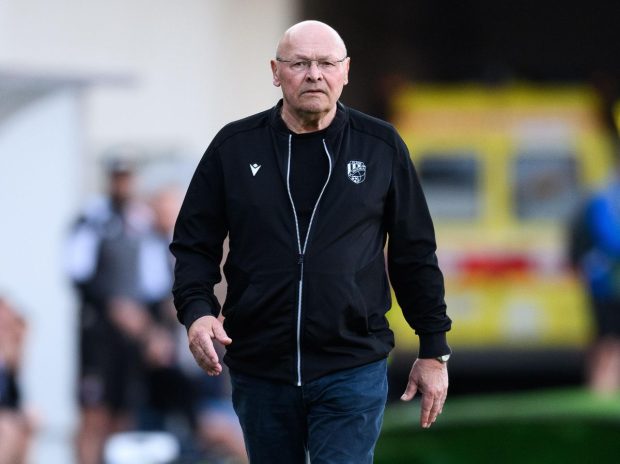
This has to be it: the end of the Shanaplan, the end of the Core Four Toronto Maple Leafs.
There’s no running it back. Not after this. Not after maybe the most embarrassing loss of this era, which came four nights after the other most embarrassing loss of this era. Not after letting a 2-0 series lead melt away with four losses in five games. Not after the core of Auston Matthews, Mitch Marner, William Nylander and John Tavares failed again when it mattered. Not after seven tries with that core.
Advertisement
Not after six straight Game 7 losses in that era, with a single goal scored in the last five of them.
Not after four goals — total — in the final four games of this second-round series.
This is the end of something. It has to be.
Leafs president of hockey operations Brendan Shanahan’s mistake wasn’t that he believed. It was that he failed to adjust that belief when the evidence screamed for it. His stubbornness was the real failure.
Shanahan seemed to believe that given enough time his faith would eventually be rewarded, just like it was for Washington and St. Louis: teams that won Stanley Cups in 2018 and 2019 after long runs of playoff futility. The plan didn’t matter so much as sticking to it did.
He even had personal experience from his playing days that if a team just stuck with it long enough, they would come through. Before he joined the Detroit Red Wings in 1996, the team boasted a Steve Yzerman-led core that failed perennially in the playoffs. They went deeper than this Leafs team ever did, but didn’t win it all until 1997, when Yzerman was 32.
Yzerman wasn’t a winner until he was. The Wings weren’t a winner until, suddenly, they were.
The Leafs could be too. That was the Shanaplan.
What Detroit did along the way, though, was adapt. And the irony: it included Shanahan.
In October of 1996, the Wings dealt Paul Coffey (a future Hall of Famer and Wing since 1993), Keith Primeau (the Wings’ third overall pick of the 1990 draft and a player with disappointing postseason resume), and a first-rounder in 1997 to the Hartford Whalers for Shanahan, the ultimate power forward.
Shanahan was the piece that put Detroit over the top. The Wings won the Stanley Cup in 1997, 1998 and 2002.
But the Leafs he ran never found their Shanahan. They changed the supporting cast, they tinkered around the edges, but they never made a bold shift in direction. The nucleus was always the big four forwards plus Morgan Rielly; it thrived in the regular season, dominated the regular season, but melted in the playoffs again and again and again and again.
What Shanahan couldn’t recognize, ultimately, was the difference between great players and great players who could win together.
So what now, with the Leafs still two rounds and nine wins short of their goal of winning a first Stanley Cup in nearly 60 years? Is this actually it for Shanahan and the run-it-back approach that’s come to define his tenure?
The list of instances when “it” felt inevitable is long and dates back at least to 2021 when, after a 3-1 series lead over the Montreal Canadiens evaporated in disastrous fashion, Shanahan said, “I’ll say this about our top four: I think any team in the league would love to have any one of them. But we want them. We like them. We want to keep them here.”
Advertisement
The window for major change creaked open ever so briefly in 2023 when then-GM Kyle Dubas, still without a contract extension and wondering about his future, said that “perhaps the path needs to shift slightly and needs to be adapted slightly” and then added, “You get in between persistence and full belief versus being a little too staunch and rigid.”
For Shanahan, it was full belief — still.
Dubas was fired in the midst of contract negotiations and his replacement, Brad Treliving, implied change wouldn’t come after all, not with the core. “You can throw a body under the tarmac and it might look good for a headline, but are you getting any better?” Treliving said after he was hired. “At the end of the day, it’s about getting better. And just being different doesn’t necessarily make you better.”
That was the time, if there was ever a time, to pivot – and from Marner specifically.

Mitch Marner and Brendan Shanahan talk to the media ahead of the 2023 All-Star Game. (Jeff Vinnick / NHLI via Getty Images)
The Leafs weren’t trading Matthews, who combined the rarest of abilities as a No. 1 centre: all-time great scoring and elite defensive ability. They likely weren’t trading Nylander, on the rise and unbothered by the scrutiny that came with being a Leaf, either. Tavares had a full no-movement clause and an $11 million cap hit.
At that point, Marner had two years remaining on the six-year contract that didn’t come easy. He had already appeared unnerved by the fishbowl environment of the Leafs and had struggled in the playoffs. The no-movement clause on his contract didn’t kick in until July 1.
That was the pivot. The Leafs had a month to find a trade and could have altered the fabric of their team somehow.
The fear from within always boiled down to the challenge of trading Marner and coming out a better team. In other words, if they couldn’t get a superior player back in the trade, what was the point?
Advertisement
They chose to believe, again.
It wasn’t just they ran it back, either. It was their all-out determination to never make things the least bit uncomfortable for the core. That came with the largely player-friendly contracts (one of which, Nylander’s second NHL deal, came after the longest dispute in salary-cap history), the lack of much public pressure, not pressing no-trade clauses to facilitate potential trades, to even something as subtle as Marner and Matthews sharing the second alternate captain’s letter during the five years of Tavares’ captaincy.
So what now?
Shanahan’s dismissal after 11 seasons in charge and two playoff rounds won feels like an inevitability, but inevitability with the Leafs is dangerous. To assume anything at this point would be foolish.
Shanahan might sell MLSE president and CEO Keith Pelley on his team pushing the Panthers, a team that’s been to two straight finals, to Game 7 even without No. 1 goalie Anthony Stolarz. He might sell them on the apparent progress of the group under first-year head coach Craig Berube and how, with a healthier Matthews and a solid defence in place, this team may not be far off from winning for real.
It’s not hard to imagine Shanahan sticking around somehow — even if it is, well, hard to imagine after so long and so much of the same.
The need for a new viewpoint at the top of hockey operations is well past due: a new vision from someone who can guide a slightly different path for the Leafs that doesn’t include all of Matthews, Nylander, Marner, Tavares and Rielly.
Who is that person? Is it Treliving? Is it someone from outside the organization? What do they see as the future for this team? Does it include Treliving, who had a better second year as Leafs GM but crucially misfired on upgrading the centre position?
The biggest change that the Shanahan-Treliving front office made last summer came in the coaching department. Ultimately, swapping out Sheldon Keefe for Craig Berube failed to deliver the change that was promised.
Berube’s Leafs lacked the offensive punch they needed when it mattered, just like the Keefe teams. The Leafs scored zero goals in Game 4, one goal in Game 5, two goals in Game 6, and one in Game 7.

Auston Matthews and Florida goalie Sergei Bobrovsky share a word in the handshake line after Game 7. (John E. Sokolowski / Imagn Images)
Regardless of who it is leading the Leafs moving forward — if it’s someone new at all — that path is almost certainly going to include Matthews, who has three years left on his contract, and Nylander, who has another seven left on the deal he signed early in 2024.
After that, it’s murky.
The team always hoped that one year, as he got older and more mature, it would all click for Marner. He would shrug off the criticism and not let it bother him that his fellow co-stars weren’t judged as harshly as he was. He would quiet the noise around him.
Advertisement
Instead, he was held to one point in the final four games of the second round. He scored twice in 13 postseason games this spring.
Does Marner still want to be here? Would new leadership (if it is new) want to keep him? He could have signed an extension during the season and chose not to and never clarified why. It sure feels like the time has come for him in Toronto, that he and the Leafs might be better off going separate ways.
The Leafs will also need to decide if now is the time to call it on Tavares. Unlike Marner, Tavares has made it clear he wants to stay. He had another strong regular season at 34 but couldn’t find another gear against the Panthers as the No. 2 centre. The former captain was held without a point in six of the seven games, but it might be hard to resist keeping him around if he’s willing to accept a true bargain on a short-term deal (especially if extra money is around in the event that Marner doesn’t stay).
Much about the Leafs will stay the same. Seven forwards are under contract, not including Matthew Knies, a restricted free agent. The entire defence is locked up and so are both goalies.
But real change may finally be on the way.
The time has come. It came a long time ago. It came too late.
(Top photo of Auston Matthews and Mitch Marner: John E. Sokolowski / Imagn Images)
This news was originally published on this post .






Be the first to leave a comment